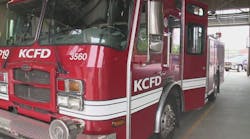No, this isn't Body Odor. It's your Building Official! All too frequently, there are adversarial relationships between fire officials and building officials. Unfortunately, this creates a difficult environment, not only for both officials, but their staff and external customers too. How silly is it that the two most influential and powerful people pertaining to building and fire safety can be at odds with each other regarding fire and life safety issues? It is only right that we should work to eliminate this strife. Don't they both have the same goal of a safe building?
Here are just some of the reasons often cited for causing friction between fire and building officials?
- Building officials don't understand or care about fire issues
- Building officials are in bed with the contractors and concerned about economic development
- Building officials are too political
- Fire officials aren't technically competent in the codes and have little formal education
- Fire officials are badge-heavy egomaniacs
- Fire officials always see the world as doom and gloom and base interpretations on "worse case scenarios"
First of all, doesn't it make sense building officials may not understand fire issues as well as fire officials? How much time and effort has been spent by fire officials helping building folks understand the fire department's mission? How familiar are fire officials with all the things a building official has to deal with? The statement of "not understanding" often goes both ways. It is important for building and fire officials to establish an open, honest relationship. This includes one-on-one communication. Both individuals must be cognizant of the other's mission, obstacles and strengths. Only through this common understanding can both leverage the other's capacity and understanding to do the right thing...an effective job of gaining code compliance and providing a safe building for occupants and the fire fighters who may be called to mitigate an emergency in the building. Successful fire prevention programs are built upon coalitions. Your building official should be your strongest coalition in fire prevention!
Building officials typically spend much more front-end time with contractors and the development industry than the fire service. Many times this is because of the structure of the organization in which building departments are found. Many times the building department is organizationally in the same division as community or economic development and planning. Many building officials find this to be organizationally a conflict in the intent of providing life safety services. Building officials may have worked in the construction trades and some have formal education of common building practices.
The building official must be closely in tune with the contracting community, as they are his/her primary customers. Naturally the building official provides a service that ultimately benefits the general public by protecting their interests for health, safety and welfare. They are the first line of contact with the developer in discussion of how the development fits into the master plan for the municipality. Typically, the permitting process is managed through the building department. A conflict between individuals and departments directly impacts the contractors and developers because they depend heavily on their decisions/interpretations and jurisdictional requirements. Many times these decisions cost them time and money.
Another often misunderstood and overlooked issue is that of economic impact. If anyone has been paying attention to the economic picture lately, the building and construction industry is having a tough go of it nationally. Excessive or unreasonable building requirements or processes can exert pressure on this industry that is immediately transferred to building departments. A building official has many bosses and critics. They are generally required to walk a much tighter rope than fire officials and as a result must react and adjust more frequently. Their impact can literally make or break economic growth issues in a community. It is therefore imperative that fire officials step back and try to walk a mile in the building official's shoes before discounting them or their motives. Building Officials are concerned about the economic "tight rope" they have to walk. We are not implying building officials are the only ones taking heat; we are merely suggesting that fire folks should take the high road and take the necessary steps to secure a good working relationship. Both building and fire departments can be scrutinized over code requirements and the impact on economic development. It is for this reason alone that makes it imperative that both departments have a solid working relationship and understanding of each others roles and responsibilities. A strong coalition can help prevent developers, contractors and even elected officials of playing both departments against each other.
Politics is the name of the game in any high-profile position. Just ask your Chief. If a fire official is intimately involved in his or her local government, they too will be experiencing political pressures. While unattractive, this is just a normal consequence of our jobs. We must be aware of these challenges and be professional in carrying out our duties without ever jeopardizing the safety or well being of others.
One definition of politics is nothing more than compromise. Compromise is a very important function of our job, whether it is with our employees, administration or the design and development industry. A building official does the same thing. If a good conversation were held between fire and building officials, it would be readily evident that both likely are experts in the political arena. If there is a collaborative and cooperative relationship between the two, they can use politics to their advantage, which ultimately plays to the betterment of fire and life safety to the community. Again, working together is far more effective than working independently. Remember there is strength in numbers and consistency. By far the best example of this is jointly presenting code changes to the elected body for approval. Understand each other code modifications and why they are being proposed for approval. If your building official understands the benefit of automatic fire sprinklers he or she will be more likely to support your proposal. Consequently, the fire official must understand the proposed building code changes and support the building code changes proposed by the building official.
Building officials frequently suffer the effects of decisions a fire official has made, without having the benefit of knowing the reasoning or facts behind the decisions. The building official can end up fighting a battle on behalf of the fire official without having enough ammunition. This can quickly lead to resentment and frustration that is not only unfortunate but also unnecessary. Establishing a good relationship between both officials not only facilitates communication but also helps to establish trust, which can go a long ways in accomplishing a common mission of public protection. Having a good relationship with the building official may allow you as the fire official to become involved in the project during the conceptual design and preliminary talks with the developer. The fire official needs to use this opportunity to show a willingness to help and welcome the developer and not be adversarial during the first meeting with a proposed development. The building official can assist in paving the communication highway.
There is an old saying: "When the fire marshal walks in, the milk curdles." Basically, this infers that people get uncomfortable, nervous, intimidated, etc. in the fire official's presence. Why is this? It is because the fire official can have a lot of clout and impact the cost of the development. This is not a bad thing unless the clout creates an attitude that makes the fire official seem unapproachable. The fire official typically has a very hard job and is responsible for a lot of things that a building official may not be aware of. Regular conversations between the two will help equalize the perception of the playing field and allow both individuals the opportunity to find common ground. It will also so unity during conceptual design meetings.
The last important barrier is how both officials view their world. In many ways in many jurisdictions, the building official's responsibility for a building is mostly complete as soon as the certificate of occupancy is issued. The fire official, however, is responsible for the building for its lifetime. This creates a significantly different perspective of problem ownership and outcomes that forces the fire official to be more conservative or as some would say pessimistic.
The fire department must deal with the outcome of code compliance successes or failures while the building department may never "see" the building again. Obviously this warrants a little more "doom and gloom" perspective on the part of the fire officials so that proper and lasting decisions are made. Frequently building officials do not understand, or forgets this perspective. Again, communication between both officials is critical. Without open communication neither will understand the others motives.
How do we establish the communication? First, how about lunch? Inviting one or the other to lunch is a great way to establish neutral ground, a comfortable atmosphere, and a way to start conversation. Make a recurring appointment. Visit regularly to talk about common problems. Make a list of issues that both departments would like to address. Be patient but diligent and keep hacking at the list.
Use the expertise of the building official in the development of the Emergency Operations Plan. Find ways to integrate the building official as part of the incident command structure at large incidents. At some point, someone will need to determine if the structure is fit for occupancy. If your fire department establishes an occupant service division during an incident, building officials can be critical in expediting the recovery process after the incident.
Coordinate training opportunities. Frequently the fire service has more training opportunities than building departments. Take the initiative to invite building inspectors to attend fire code or inspection training. Remember, the building code is roughly 40-60% fire safety requirements. Why would they not be interested in fire related training? These interactions provide an opportunity for both departments to collaborate, talk about issues and establish rapports with their peers. One of the best examples of this was at recent seminar hosted by fire officials regarding residential sprinklers. Unfortunately very few building officials were even in attendance. Did their fire official ask them? How can the fire official expect to pass a residential sprinkler ordinance if the building official is not supportive? Provide opportunity to educate the building official about fire related topics. In turn become willing to attend building code seminars with your building official and understand his or her issues.
Rely on each other's expertise and call for help more frequently. Second opinions are never a bad thing. Another opportunity can be presented during common meetings. Try to sit together as this can help present the image of a united front on issues in the meeting. Even when you disagree with the building officials code interpretations do not discuss it in the meeting. Have an understanding before the meeting that if there is a topic that either wants to explore further, either the building or fire official can bring it up as "WE need to examine this item together in greater detail and will respond to you at a later date." You can then hash out your concerns in private and come to a consensus. Disagreements are inevitable between building and fire departments. It is the strong relationship that allows those issues to be resolved in a diplomatic and professional manner.
Fire and building codes are companion documents. It only makes sense that fire officials and building officials become companions in the professional world. Both are concerned with fire and life safety and therefore should work in tandem to maximize their efforts and convey a positive image. This type of leadership portrays the importance and strength of the fire and life safety requirements requested by the building and fire officials.
Contributions to this article made by Building Commissioner William Schroeder, MCP
Brett Lacey is the Fire Marshal for the Colorado Springs (CO) Fire Department. He is a professional engineer and certified safety professional. Paul Valentine presently serves as Fire Marshal for the Mount Prospect Fire Department in Mount Prospect Illinois. Prior to the position of Fire Marshal, he was the fire protection engineer for the Mount Prospect Fire Department. Brett and Paul co - authored the text Fire Prevention Applications published by Fire Protection Publications, Stillwater Oklahoma. The text can be purchased here.




